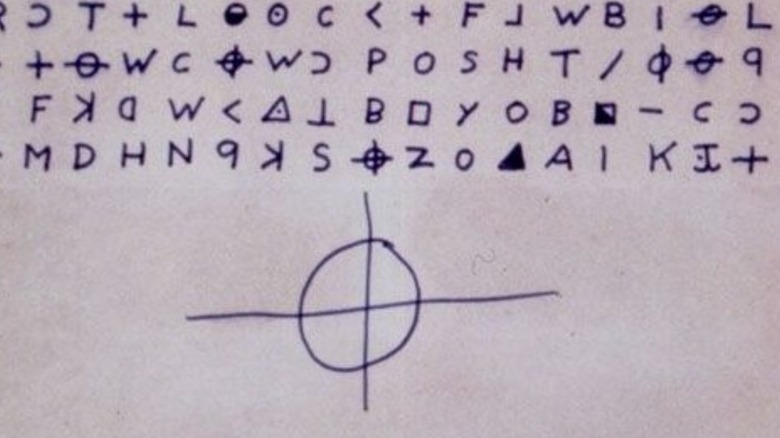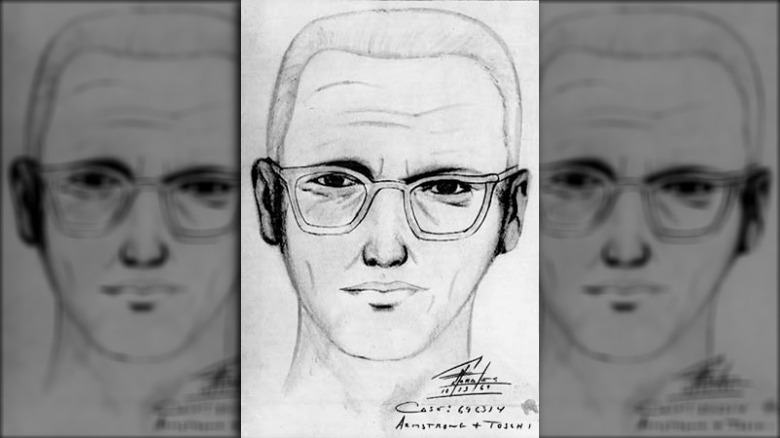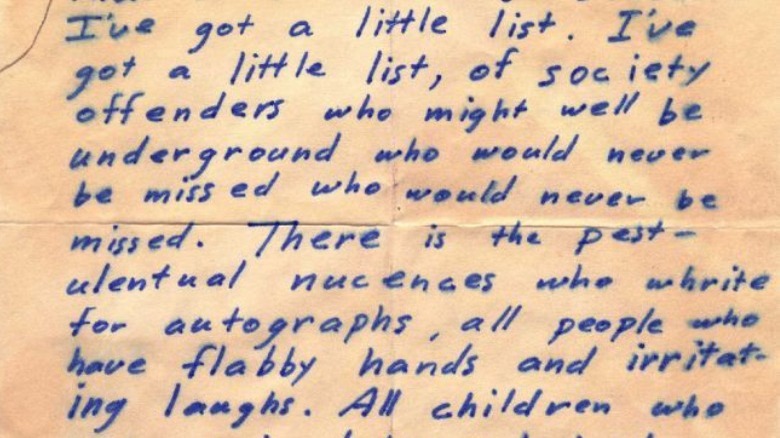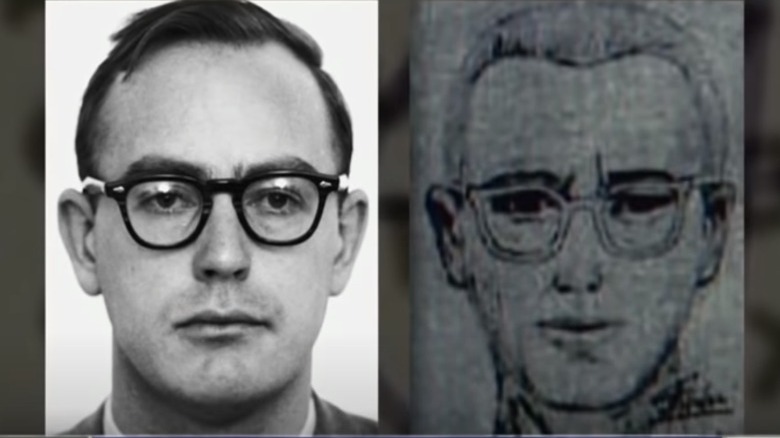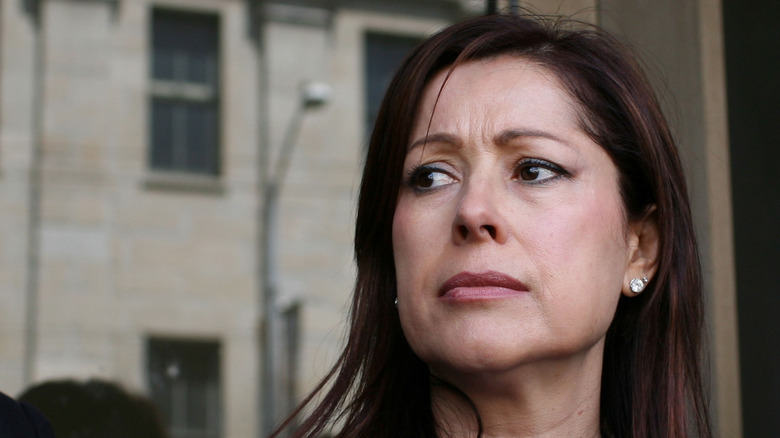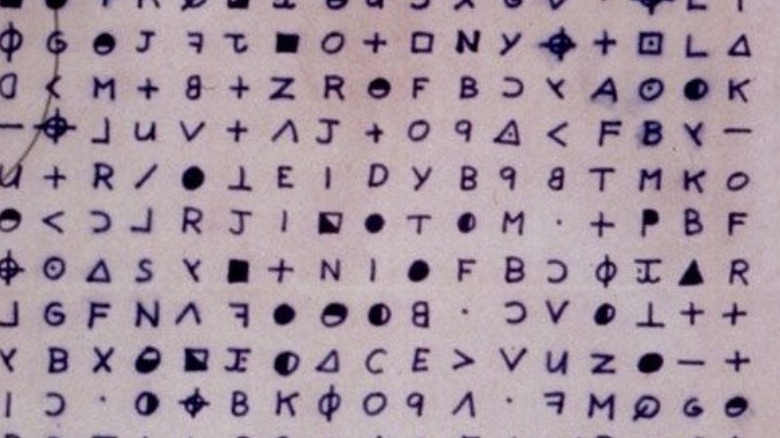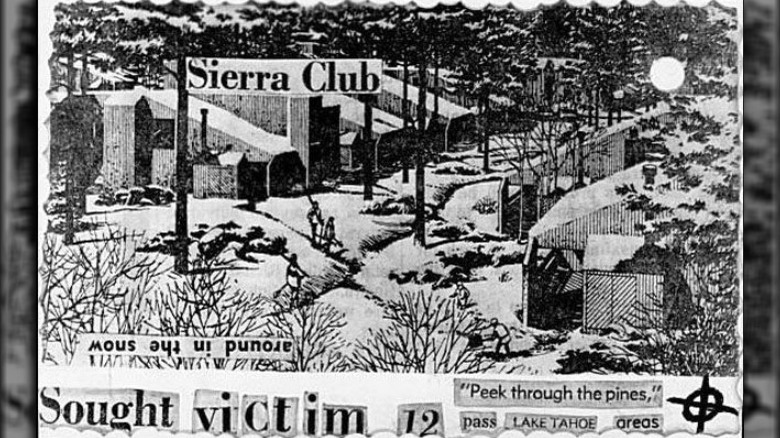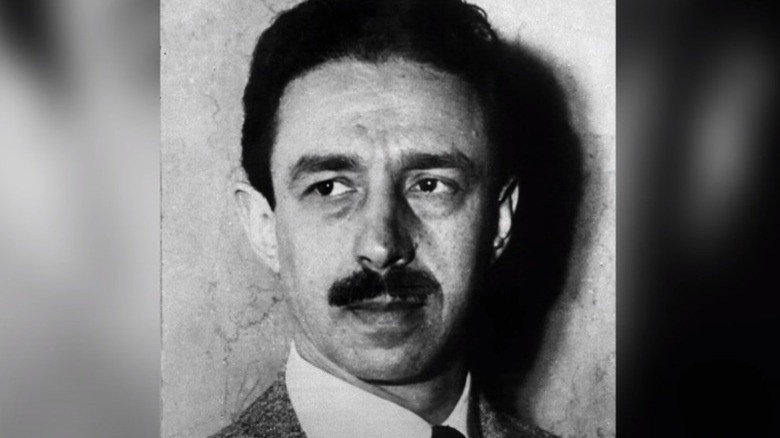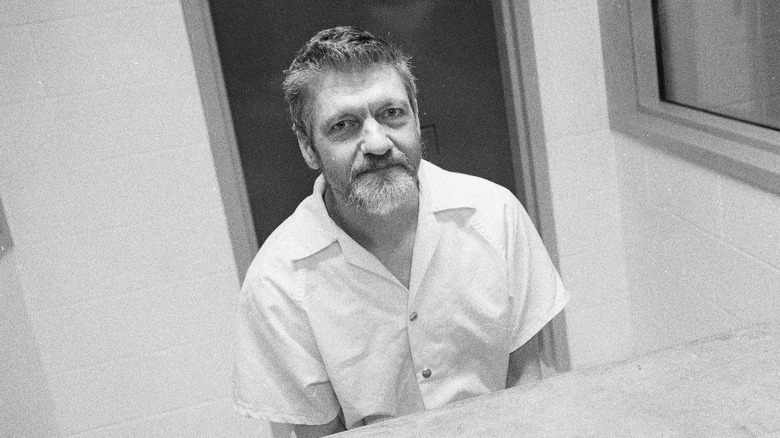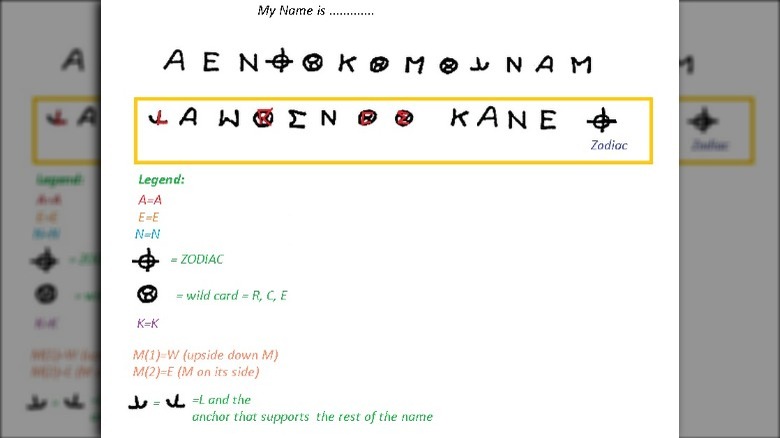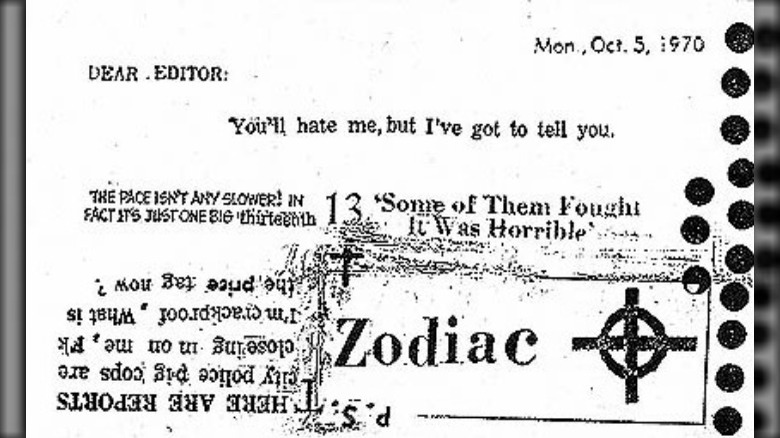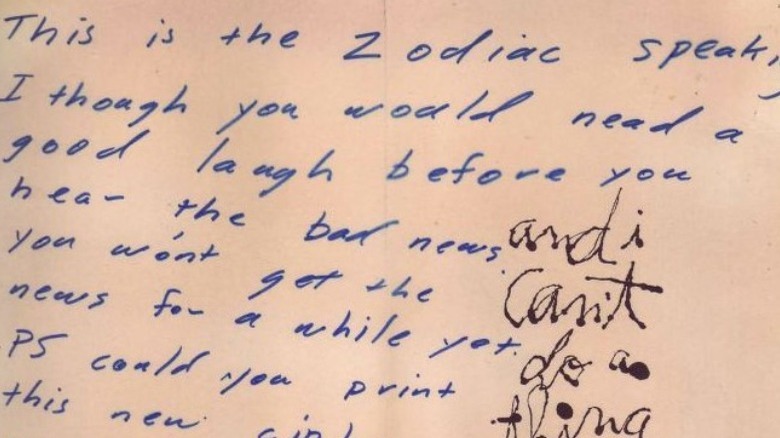Every Big Suspect Accused Of Being The Zodiac Killer
In the last days of 1968, law enforcement was called to a crime scene that the San Francisco Chronicle called "unusually messy." The victims were 16-year-old Betty Lou Jensen and 17-year-old David Faraday, and they would be the first known victims of one of the nation's most notorious serial killers.
In less than a year, seven people would be attacked by the shadowy figure that would come to be known as the Zodiac Killer. Two — Michael Mageau and Bryan Hartnell — would survive an attack. It's those two survivors who gave the description of the killer that remains one of the few pieces of evidence in the case. Aside from, of course, the mysterious letters that were sent to the Chronicle.
One of those letters — called the 340 Cipher — was only cracked by code-breakers in 2020. The Chronicle reported that it had taken 51 years for the killer's code to be broken, and to reveal eerie messages like "I hope you are having lots of fun in trying to catch me. ... I am not afraid of the gas chamber because it will send me to paradice (sic) all the sooner because I now have enough slaves to work for me."
At that time, law enforcement confirmed that the case was still open. Let's take a look at the suspects, including one named in 2021. Who's the real deal?
Gary Francis Poste
The Zodiac Killer had seven confirmed victims over the course of five attacks, but letters sent to the media and law enforcement laid claim to 37 murders. And according to a group of cold case investigators called the Case Breakers, those extra murders are the key to identifying him.
The Case Breakers — which is a group of investigators that includes 40 members with backgrounds including law enforcement and military intelligence — say the Zodiac Killer is a man named Gary Francis Poste. Their investigative trail starts with the murder of Cheri Jo Bates, who isn't typically considered a Zodiac victim, but who the Case Breakers believe was actually his sixth victim (via Fox News). Bates was killed two years prior to the official start of the Zodiac's reign of terror, and the Case Breakers have drawn a lot of connections among Bates, Poste, and Zodiac.
Poste, who died in 2018, looked very much like the sketches of the Zodiac that were based on witness descriptions, even down to the scars on his forehead. Further, as a house-painter, he could be connected to a paint-splattered watch that was left at the scene of Bates' murder.
Perhaps most interesting is the ciphers. Investigators say that one of the letters sent by the Zodiac included his name... sort of. One message had a series of letters removed from it — letters that spelled out "Gary Francis Poste."
Arthur Leigh Allen
When it comes to the official suspects, the San Francisco Chronicle says that there was only ever one: Arthur Leigh Allen.
Allen, a former teacher, already had a criminal record for child molestation when he was connected to the Zodiac Killer in some compelling ways — including the fact that one of the men who survived the Zodiac picked Allen out of a lineup. Allen and the killer wore the same shoes with the distinctive tread, and at least one of Allen's friends said that he'd kind of confessed to them. Allen had used only a single sick day during his time as a teacher — the same day that Cheri Jo Bates was murdered.
When Thought Catalog compared what was known about Allen to the serial killer profiles built by FBI agent John Douglas (of "Mindhunter" fame), they found there was a lot there. Allen was dishonorably discharged from the Navy, reportedly abused animals, and told a friend that he fantasized about killing random couples. Allen had also made no secret about what his favorite book was: "The Most Dangerous Game," a tale about a hunter who decides to make humans his targets. The book also crops up in one of the Zodiac's ciphers.
Ultimately, Allen was never charged. His handwriting wasn't found to match the letters, and law enforcement never built a strong enough case to charge him before he died of a heart attack in 1992.
Robert Tarbox's merchant marine
The Zodiac Killer murders happened in 1968 and 1969. In the early 1970s, a man walked into San Francisco attorney Robert Tarbox's office and confessed that he was the killer(via SFGate).Tarbox was a maritime lawyer, and the man in question was a merchant marine. The seaman reportedly told Tarbox that he wanted to stop killing, and his description of the murders was "not in detail, but it was comprehensive" enough that the attorney had no doubt that he had spoken to the Zodiac Killer. Then, he said nothing for years, citing attorney-client privileges.
In 2007, the movie "Zodiac" named Arthur Leigh Allen as the killer, and Tarbox says that he knew that was wrong — and that he couldn't stay silent any longer. While still refusing to give the name of the actual killer, Tarbox decided to go public, saying that it wasn't Allen, it was this mysterious merchant marine. Tarbox said: "I want to do this for Allen's family, and for the people who knew him. They deserved to know that he wasn't a serial killer."
Is there anything to the claim? Law enforcement says it's entirely possible — they acknowledge Allen was a less-than-perfect suspect. Tarbox's claim has also gotten support from Robert Graysmith, the writer often considered to be the expert on the Zodiac case. One of Graysmith's original theories was that the Zodiac had been a merchant seaman, so Tarbox's claim isn't the first time it's been mentioned.
Earl Van Best, Jr.
In 2020, Vulture profiled the FX true-crime series "The Most Dangerous Animal of All," and it was... weird. The series was based on a book of almost the same name — "The Most Dangerous Animal of All: Searching for My Father... and Finding the Zodiac Killer" — written by journalist Susan Mustafa. At the heart of the story was Gary Stewart's search for Earl Van Best Jr., the man who had gotten his mother pregnant when she was 14, then later abandoned the child in the stairwell of an apartment building.
Stewart's book claimed that along the way, he found not a father, but a serial killer. He had a bucket of evidence, including sketches, handwriting, and partial DNA that seemed to match. Mustafa believed every bit of his claims, but here's where things get weird.
Director Kief Davidson and executive producer Ross Dinerstein did their own investigation, and along the way, they disproved every one of Stewart's claims. Wondering what they were going to do with their show, they followed Stewart's journey to find his father, and ultimately, told him what they'd discovered. Most tellingly, they tracked Van Best Jr. to Europe at the time of the Zodiac's confirmed killings.
When they let Stewart see the finished series — and all the debunking it did — ahead of release, he said he loved it. And that? It left producers wondering what the heck had just happened.
Guy Ward Hendrickson
In 2009, some strange news hit the headlines. Fox News reported that a California woman named Deborah Perez (pictured) claimed that she knew her father, Guy Ward Hendrickson, was the Zodiac Killer for some shocking reasons. Not only did she say that she had actually been the one to write the letters that he then sent to law enforcement and the media, but she'd embroidered his hood, too.
Perez said that she was 7 years old at the time, and went along with her dad when he went on his killing sprees. "He told me he was sick, and all I wanted to do was help my dad. He kept telling me he was sick and he killed many, many people. I had no idea."
Attorney Kevin McLean said that his own two-year investigation into the claims — which included Perez submitting to a psychiatric evaluation — found that there was something to it. Not everyone agreed.
Perez's stepsister, Janice Hendrickson, publicly condemned the idea that her father was a killer. She said (via SFGate): "If the evidence proves that my father was Zodiac, I will apologize, but if not, I will sue for defamation."
Hendrickson had died years before, in 1983, and according to the Orange County Register, police later said that Perez's evidence hadn't panned out, and the smoking gun she thought she had — the eyeglasses of Zodiac victim Paul Stine — wasn't legit, or proof of anything at all.
Ross Sullivan
According to Bustle, the name Ross Sullivan pops up more often in online forums than in official investigations, but the publication also notes that since investigations are still going on, that might not be that surprising.
Sullivan is also featured in the History Channel's "The Hunt for the Zodiac Killer," and it, too, connects him to the Zodiac via the murder of Cheri Jo Bates. Sullivan was a Riverside City College student at the time Bates was killed, and he also worked at the place she was last seen alive: the library. Those who knew him have described him as the sort of person who made others uncomfortable, and said that he had constantly worn military boots — the same kind of boots that were connected to prints found at the site of Bates' murder, and the Zodiac Killer's Lake Berryessa crime scene.
What's more, Sullivan was a student of cryptology, which supporters of the theory say would be handy in writing the ciphers that have stumped law enforcement and codebreakers for decades. He also fit the physical description of the killer, was diagnosed with schizophrenia and bipolar disorder, and moved into the Zodiac's killing grounds just before the murders started.
It's unclear exactly what happened to Sullivan, but it's believed he died in 1977.
Richard Gaikowski
There are a few people at the heart of the investigations into the Zodiac Killer, and Tom Voight is one. He's behind ZodiacKiller.com, and in 2020, Portland interviewed him about who was at the top of his list of suspects.
That was Richard Joseph Gaikowski, an ex-Army medic from South Dakota. Gaikowski ended up in California by 1963, and in 1971, his coworkers got together to have him committed to the Napa State Mental Hospital. He was treated, went on to run a movie theater, and eventually died in 2004.
Why does Voight think he's the Zodiac Killer? Gaikowski was working as a journalist and editor in the area at the time of the killings, and he tended to show up in circles around the Zodiac. One of the Zodiac's victims, Darlene Ferrin, reportedly had a journalist ex named Richard, and her boyfriend Michael Mageau — who survived the Zodiac's attack on himself and Ferrin — later said that she knew "Richard" was jealous, and stalking her.
Gaikowski's voice was identified by the police dispatcher who had taken a call from the Zodiac Killer, saying, "I listened to the voice of Richard, and felt shock and deja vu. In my opinion, he was the same person I listened to in July of 1969."
Voight had first been tipped off about Gaikowski by one of his former coworkers, who had gone to the police with the same information in the 1980s. Unfortunately, the coworker says that because they're transgender, they were written off entirely and the lead was never taken seriously.
George Hodel
Steve Hodel has an impressive law enforcement career that includes decades as a member of the Los Angeles police department, but after the death of his father, his relationship with murder suddenly got a lot different. He was going through his father's belongings when he found questionable photos — photos that looked a heck of a lot like Elizabeth Short, the aspiring actress who was murdered and immortalized as the Black Dahlia.
According to The Guardian, Steve started digging and found piles of evidence that suggested his own father, George Hodel, had been the one to kill Short, sever her body in a difficult procedure called a hemicorporectomy, and leave her to become one of the greatest mysteries in true crime history.
Steve firmly believes that Short's 1947 murder was just the beginning, publishing a book called "Most Evil: Avenger, Zodiac, and the Further Serial Murders of Dr. George Hill Hodel," which argues that his father was responsible for the Zodiac killings. George's return to California from the Philippines happened about the same time the Zodiac killings started, and Steve argues that the profile matches his father too well to be a coincidence.
Others are less convinced, with The Daily Mirror citing facts like the shoe sizes of George Hodel and the killer — one of the biggest pieces of evidence — aren't even a close match (via the LA Times).
Ted Kaczynski
The name Ted Kaczynski should definitely sound familiar, as he's been known as the Unabomber for years. As of 2021, he was still behind bars at a Colorado supermax prison, but there are some who think he wasn't just the Unabomber, and that he was also the Zodiac Killer.
SFGate says that when Kaczynski was still officially only a Unabomber suspect, tips started flooding into San Francisco law enforcement and to the San Francisco Chronicle. A whole bunch of people were pretty sure that Kaczynski was the killer. He was living in San Francisco at the right time, he loved to send letters bragging about what he'd done, and someone had a yearbook he'd signed with a drawing that looked like the famous zodiac symbol.
Kevin Fagan, the Chronicle reporter who has been covering the Zodiac case for the longest, calls the idea "preposterous." Author and Zodiac researcher Mark Hewitt doesn't think so, though. His book, "Zodiologist," contains all the evidence he could find to prove they're the same (via the Times Herald). For example, Hewitt claims the Zodiac Killer's code came from Joseph Conrad's "Secret Agent," which just happened to be a favorite book of Kaczynski's. Legit, or no?
Lawrence Kane
In 2021, The New York Times reported that when Faycal Ziraoui read that two of the Zodiac Killer's ciphers were still unsolved, he figured that he would give solving them a go. Two weeks later, he went public with his success story.
Ziraoui was widely condemned by online communities that had been trying for years to do the exact thing that he said had taken him two weeks, and was basically told that no one believed him. His brother explained: "He came in and told them 'end of the game.' But these people don't want the game to end."
The ciphers he decoded contained coordinates for one of the Zodiac Killer crime scenes, and the other was even more interesting. The 13-letter cipher started with "My name is..." and of course, that's the jackpot.
Ziraoui's encryption code gave him "KAYR," which he connected to one-time suspect Lawrence Kaye. (Ziraoui says he saw the same "typo" in coding in other words, too.) Kaye — who also went by the name Kane — had been on police radar at the time of the murders... sort of. A detective named Harvey Hines had pushed him forward as a suspect, but he was ultimately overlooked. SFGate says that Kaye was connected with a 1970 kidnapping and worked at the same place as one of the women the Zodiac Killer claimed to have murdered. He was never officially a suspect, and when Ziraoui posted about him in some of the Zodiac forums, it was deleted.
Jack Tarrance
In 2008, another man put a family member forward as the Zodiac Killer. According to what Dennis Kaufman told CBS anchor Kris Pickel (via News 13), the Zodiac Killer was none other than his stepfather, Jack Tarrance.
Kaufman said that he had spent eight years compiling evidence, and argued that everything from composite sketches to handwriting samples was a match. He also said that he found a smoking gun — a literal bloody knife — while going through his stepfather's belongings, along with gruesome images on camera film, a black hood with the Zodiac's famous symbol on it, and what he says is a confession.
If Kaufman is right, then the Zodiac Killer escaped justice. ZodiacCiphers says that Tarrance died in 2006. DNA testing done after Kaufman went public with the claims were found inconclusive, leaving Tarrance firmly in the "maybe" category. Still, many say that there's no way Tarrance was the Zodiac Killer at all, and Kaufman has been widely discredited.
Rick Marshall
According to The Ringer, Rick Marshall first came to Zodiac investigator (and San Francisco Chronicle cartoonist) Robert Graysmith's attention after an hour-long phone call from a mysterious informant. When Graysmith started digging, he found there were enough coincidences that he knew he needed to find the person that the mystery caller had directed him to.
The caller claimed that Bob Vaughn — who worked with Marshall at the Avenue Theater — was in possession of evidence that Marshall had collected, kept, and stored in film canisters. Graysmith never found the evidence, but ZodiacKiller.com still lists Marshall as a suspect.
Perhaps surprisingly, Marshall has reached out to them. The site details a timeline of Marshall's life that confirms that during the time the Zodiac murders took place, he was living in San Francisco and working at a movie theater there. Marshall came under suspicion after making some odd comments overheard via a ham radio, but in 2001, he emailed ZodiacKiller.com with a correction. He claimed that all the information they had was "fifth or sixth hand," pointing out "I never lived in a warehouse in Marin. I leased an industrial property."
Marshall threatened legal action, and never responded to further attempts to contact him through the site. Things got quiet until 2008, when a nurse in the home that Marshall was living in suggested that he might be ready to talk. Detectives came to the conclusion that he wasn't the Zodiac Killer after all. No DNA testing was done, and Marshall died that same year.
